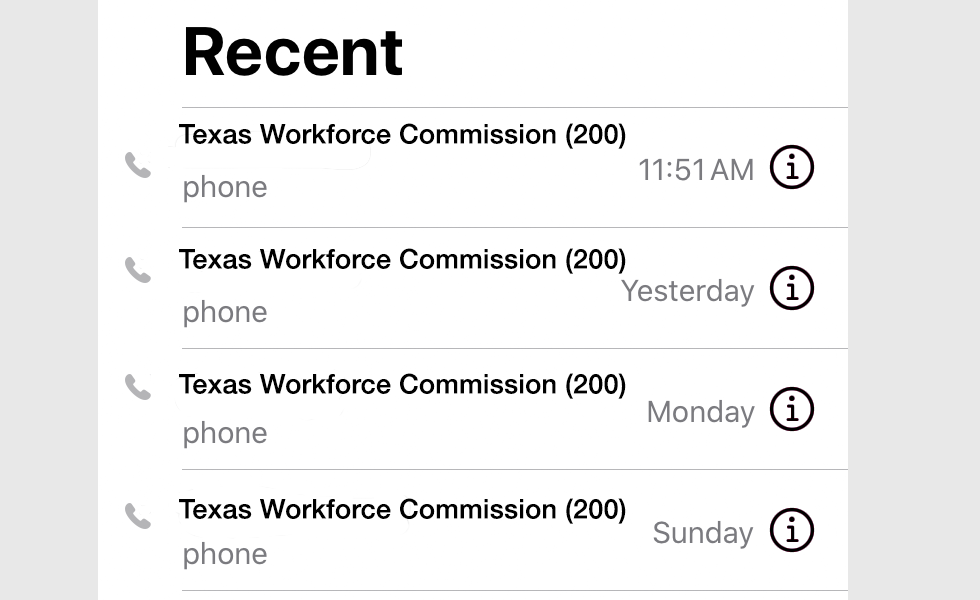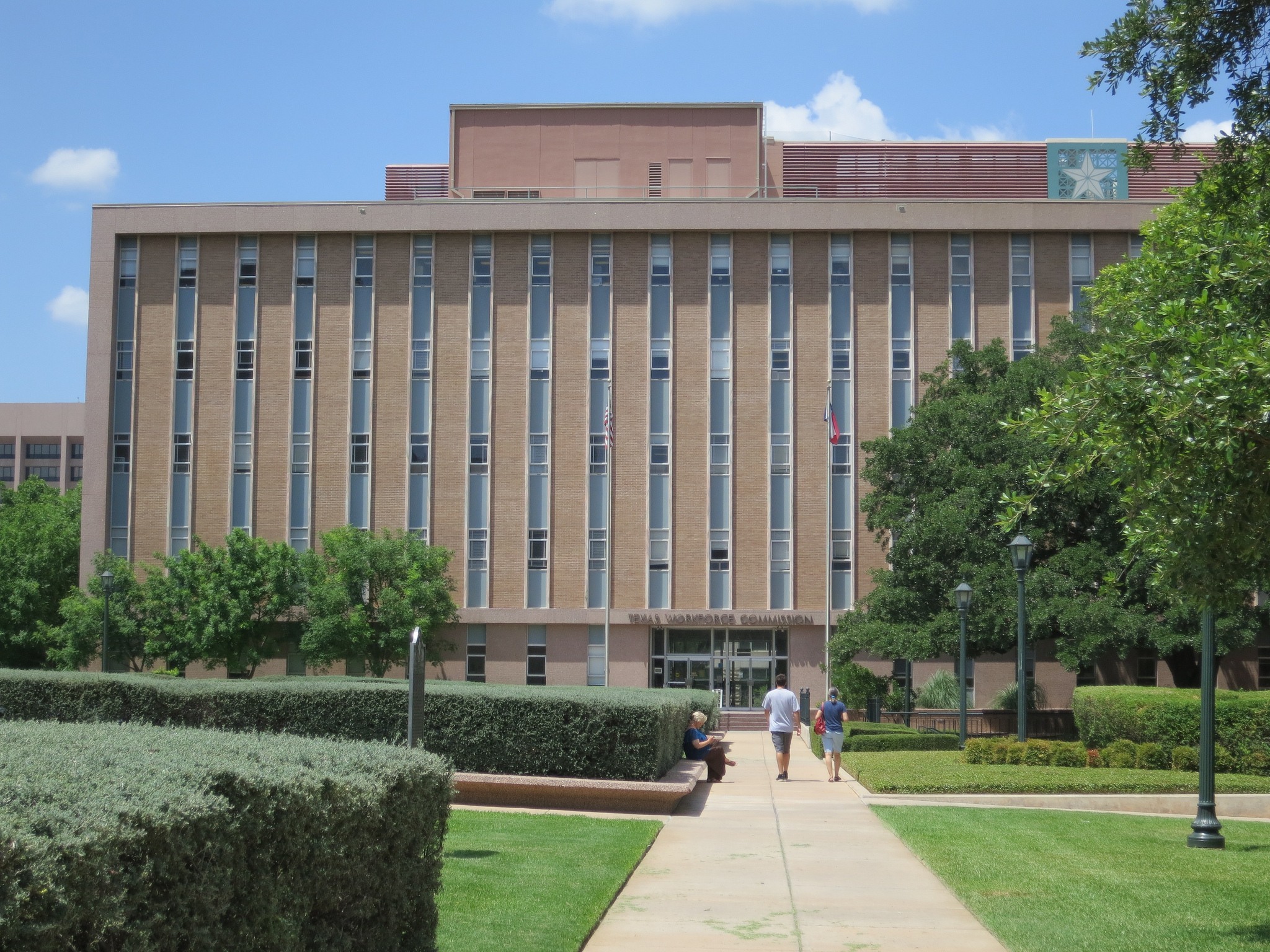
‘I’m in Limbo Here’: Texans Are Met with an Overwhelmed and Antiquated State Unemployment System
The safety net meant to support the second largest workforce in the country is using decades-old technology. The workforce agency was trying to replace it when the pandemic hit.

Four months ago, Alan Chastain moved from Louisiana to the Houston area for a promising new job as a sales representative at a sign company. By late March, Chastain had been let go.
It wasn’t a shock; as the coronavirus pandemic worsened and the economy entered a tailspin, the owner had been up front about the likelihood of layoffs. The real surprise came when Chastain began trying to file a claim for unemployment benefits. Since getting laid off two weeks ago, the 35-year-old has spent at least four hours a day trying to apply for benefits with the Texas Workforce Commission (TWC). So far, he’s had no luck.
Saturday morning, he and his 7-year-old son—each armed with a cell phone—called the agency’s hotline a combined 400 times, only to get busy signals or a recorded voice telling Chastain to apply online. But the agency’s web servers have been entirely overwhelmed by the surge of applicants, causing the site to crash and making it near impossible to enter the online portal. When he finally was able to start an online application, he was told the agency needed more information—he needed to call the jammed phone hotline in order to continue.
The Kafkaesque routine would almost be comical if it wasn’t keeping Chastain—and tens of thousands of other Texans who suddenly found themselves unemployed—from getting much-needed benefits. Chastain’s wife is unable to work and their two kids both have medical issues—his youngest, who is five, is considered at-risk for severe coronavirus symptoms. And without Chastain’s job, the family doesn’t have health insurance. “I’m in limbo here, with no solution, and no one to reach out to,” he says.
The workforce commission, which operates the state’s unemployment insurance system, says it’s doing its best in the face of unprecedented demand and was scrambling to triage an overwhelmed—and woefully outdated—system. The agency added additional servers and updated its computer systems, hired temporary workers to staff the call centers and expanded its operating hours. By the end of last week, more than 500,000 had successfully filed unemployment claims in just 19 days; TWC projected that it would have more claims filed within a month than were filed in all of last year, about 700,000.

On a typical day, the agency’s call center operators could expect to field about 13,000 calls a day. Then came the COVID-19 surge. In a single 24-hour period in late March, TWC received 130 times its average—many of them from frustrated people calling again and again. During a one-week period in mid-February, 152,000 users visited its website; during the week of March 22, 1.8 million users visited.
Last week, 361,000 applicants filed unemployment claims with the state, and 292,000 the week before. But with the system still overwhelmed, that is likely a small segment of the actual number of people attempting to get benefits. Projections have shown that the nation’s unemployment rate could soar above 30 percent. In Texas—home to the second largest workforce in the country—that could mean 4 million unemployed.
“First and foremost, to those who have been laid off, are unsure about your employment situation, or are worried for your business: We see you, we hear you, and we are working around the clock to provide the resources and help that you need,” Cisco Gamez, the agency’s spokesperson said in a statement to the Observer last week.
It hasn’t felt that way for Chastain. “They say they’re open for business, but they’re not open for everybody. I don’t feel like they’re open for mine,” he says. If he doesn’t start receiving benefits soon, he’s not sure how next month’s rent and bills will get paid. The agency says that it typically takes up to three weeks to start receiving benefits once an applicant files their claim, but that it will likely take even longer with the surge in demand. “I don’t know what else to do,” Chastain says.
Many out-of-work Texans have found themselves stuck in a frustrating feedback loop that has locked them out of the system, according to dozens of Texans who shared their personal accounts with the Observer. Desperation, confusion, and anxiety abounds.
“I’ve emailed the governor and my state representative. I have about $100 to my name and no steady income to speak of,” says one unemployed Texan. She filed for unemployment several years ago, but when she couldn’t remember her login information, she was locked out of her online account. Making matters worse, she couldn’t reset her PIN because the email address that the agency had on file was no longer active—and she couldn’t get in touch with anyone to fix the problem. “I have bills that auto debit, and I’m trying to get things pushed back but I can’t get through to those,” she says. “I may have a negative account balance soon. I’m at a loss for what else to do.”
“They say they’re open for business, but they’re not open for everybody. I don’t feel like they’re open for mine.”
As masses of out-of-work Texans turn to the state for desperately needed aid, they have come face to face with the realities of an outdated and broken government system. The unemployment system is stuck in the 20th century, a patchwork of separate systems for tax collection, benefits, and appeals that was developed in the 1980s and 1990s, according to the agency. It relies on old-school mainframe computers and a programming language that is on the verge of extinction.
To be sure, the sudden influx of people seeking benefits is unprecedented and has overwhelmed state unemployment insurance systems across the country, many of which are similarly antiquated. But a system-wide meltdown of this sort was not completely unfathomable. TWC commissioners—who are appointed by the governor—and agency leadership were well aware of the system’s technology shortcomings, as shown in a June 2018 report highlighting the agency’s strategic plan for the next five years.
The commission outlined a plan to overhaul the entire unemployment insurance system “from obsolete to newer technologies” in order to “reduce the risk of system failure” and improve the system’s “speed, efficiency, and customer service.” In the 2019 legislative session, lawmakers signed off on the commission’s request to use $40 million in federal grant money to make it happen. The agency was still trying to finalize a vendor to do the overhaul when the pandemic—and surge in unemployment—hit.
TWC told the Observer that it “considered replacing the [unemployment insurance] system in the past; however, there were not proven off-the-shelf solutions at that time. UI modernizations have evolved considerably in recent years.”
Indeed, a number of states have built new systems as things like cloud technology have evolved, with varying degrees of success. “I think there might be some wisdom in waiting for other states to [upgrade],” says Michele Evermore, a senior policy analyst for social insurance at the National Employment Law Project. “On the other hand, the economy could collapse and then your system is not modernized.”
“We were so ill-equipped to handle this [in the first place] that we’re not confident at all that they’re gonna get a handle on it any time soon.”
And the pitfalls to the latter are now on full display. The problem has been compounded by the federal government expanding much-needed benefits to independent contractors and the self-employed—workers who are otherwise ineligible for unemployment—and providing an additional $600 a week in temporary supplemental benefits. Texas, along with every other state-administered system, is now scrambling to integrate these changes into their existing infrastructure. “What’s happening right now is states are having to reprogram everything,” Evermore says. “That’s going to take some doing for states” with old technology.
Simply put, the 50-plus state run unemployment systems are not equipped for this. “These systems took years and millions of dollars to initially design and are now being asked to perform functions out of their normal scope and were not designed for the sudden exponential surge in claims virtually overnight,” says Michelle Marshel, director of external affairs at the National Association of State Workforce Agencies.
Labor advocates in Texas are not particularly optimistic that the state agency will be able to get benefits out to everyone quick enough. “We were so ill-equipped to handle this [in the first place] that we’re not confident at all that they’re gonna get a handle on it any time soon,” says Rick Levy, president of the Texas AFL-CIO.
Even still, slowly but surely, some unemployed Texans are making progress with their claims. In an attempt to lessen the crush of phone calls, the agency recently assigned time slots for applicants to call based on the first number of their area code.
On Tuesday, Chastain called at his assigned time but had no luck—despite trying 200 times. Then he went online to try and apply again. This time, he made it further in the application than he had before—until the website crashed, and he had to start over again.
He went back online again at midnight. This time, he was able to successfully complete his application. Three weeks after he was laid off, he finally got a confirmation number. Now, it could take at least another three weeks to start receiving weekly benefits.
And Chastain is one of the lucky ones.
Read more from the Observer:
-
Lessons on the Long Game from Goose Island’s Whooping Cranes: Cranes are survivors. Facing the century’s first global pandemic, they might be the sort of collective totem we need.
-
Gene Wu on Coronavirus and the Rise in Hate-Fueled Attacks Against Asian Americans: How comments from Trump, Cruz, and Cornyn inflame deep-seated prejudices against Asian Americans, further alienating them.
-
Building Trust: As Texans face the skyrocketing cost of housing, community land trusts offer the promise of permanent affordability. You just have to give up ownership of your land.



